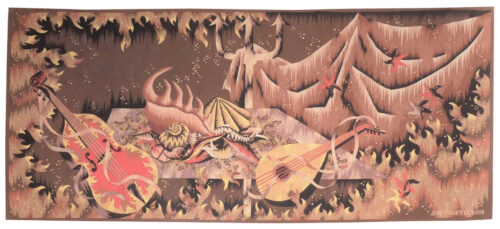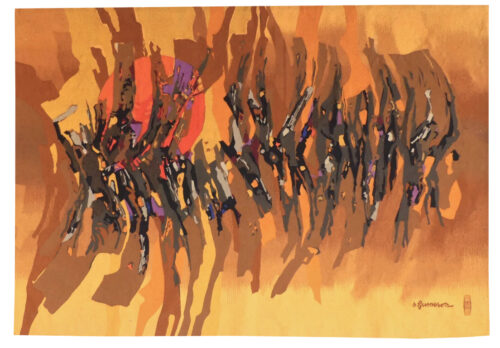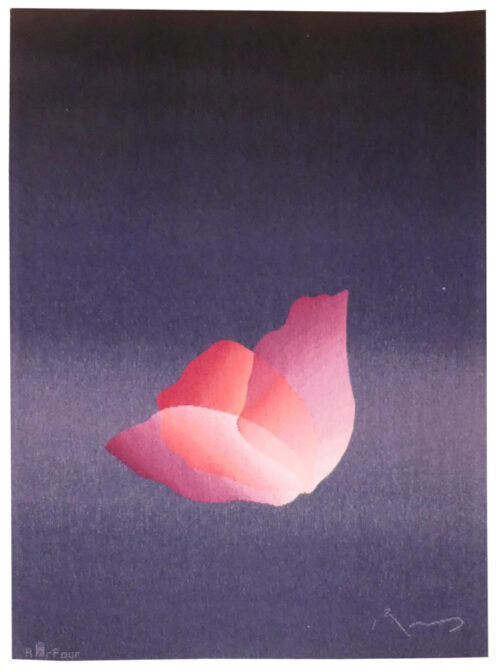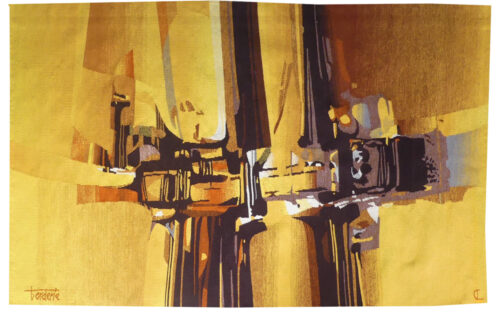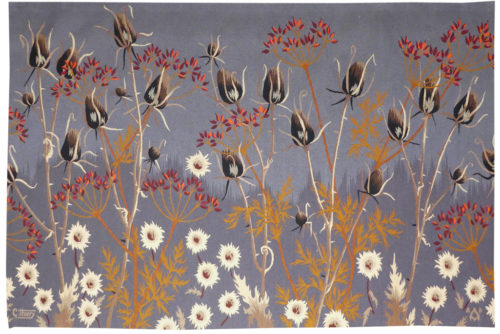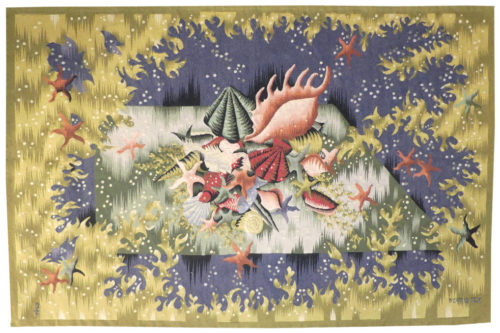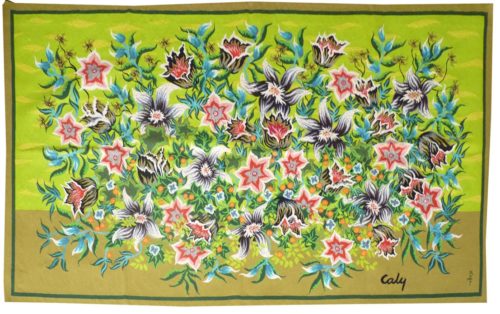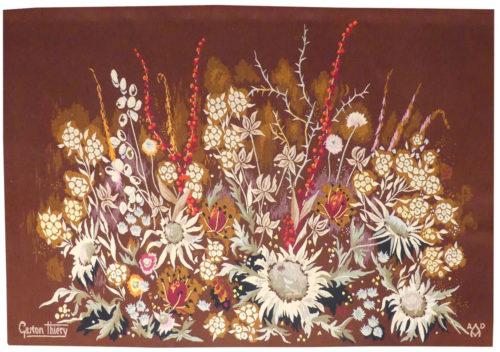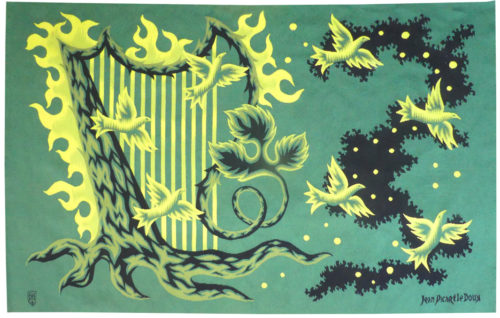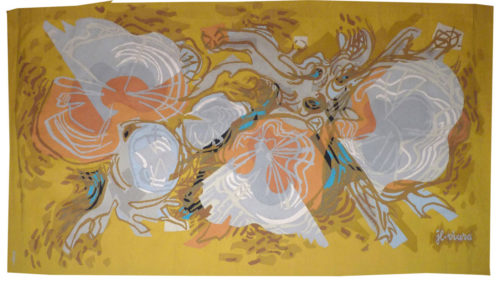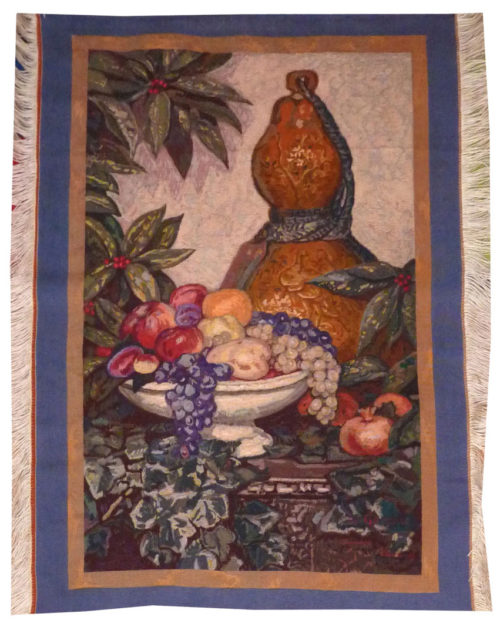-
Aubusson tapestry woven by the Four workshop. With signed label, n°EA. Circa 1960.Fumeron designed his first cartoons (he would ultimately make over 500) in the 1940’s, in collaboration with the Pinton workshop, he was then commissioned on numerous occasions by the state before participating in the decoration of the ocean liner “France”. His work was figurative to begin with and influenced by Lurçat, then turned towards abstraction, before coming back to a style characterised by colourful figurative and realistic depictions from the 1980’s onwards Fumeron's work in the 60s had a touch of the exotic about it, with his ‘Osaka’, ‘Samurai’ and ‘Monsoon’ cartoons coming to mind. But there's no literal evocation: the partially obstructed circle (Sun?) remains a leitmotif, whatever the title.
-
La grâce (grace)
Kozo Inoué moved to Paris in 1960 and devoted himself mainly to screen printing. His work was woven by the Four workshop from 1984 onwards. In his works, all of which present “grace” unfolding petals, leaves or butterflies, as if suspended, single (or occasionally multiple) motifs against a contrasting, shaded background.Aubusson tapestry woven by the Four workshop. With signed label, n°5/6. Circa 1990. -
Vent de sable (sandstorm)
Aubusson tapestry woven in the Legoueix workshop. With signed label, n°EA/2. Circa 1970.Originally a sculptor exploiting very diverse materials (steel, concrete, clay…), Borderie came to tapestry with immense enthusiasm in the 1950’s with the weaving of his first cartoon in 1957. Receiving encouragement from Denise Majorel, he was awarded the Grand Prix National de la Tapisserie in 1962. In 1974 he was appointed as director at the Ecole Nationale des Arts Décoratifs at Aubusson but he resigned from this post shortly thereafter. He designed over 500 painted cartoons, abstracts using simple shapes, shading in a limited palette of colours and weaving with gros points. A dynamic abstraction with a limited colour scheme running from orange to brown, abstract motifs which play on the plastic effect of light passing through the colours : a classic cartoon from André Borderie. Bibliography : Exhibition catalogue André Borderie « pour l’homme simplement », Angers, Musée Jean Lurçat et de la Tapisserie Contemporaine 1998 J.J. et B. Wattel, André Borderie et la tapisserie d'Aubusson, Editions Louvre Victoire, 2018 -
Jardin sauvage (wild garden)
A student of Léon Detroy, Gaston Thiéry is one of the last representatives of the Crozant school of painting. Estalished in the Creuse region of France, he started working on tapestries in 1965 with the Andraud workshop for whom he designed cartoons inspired by the local flora, in a decorative style which can be situated somewhere between that of Dom Robert and Maingonnat, a world away from his landscape paintings which were strongly influenced by the impressionists.Aubusson tapestry woven in the Andraud workshop. With label, n°6/8. 1970. -
Les petites algues (Small seaweed)
Aubusson tapestry woven by the Pinton workshop Complete with certificate of origin. Circa 1950. Jean Picart le Doux is one of the foremost figures in the renaissance of the art of tapestry. His earliest contributions to the field date back to 1943 when he designed cartoons for the passenger ship “la Marseillaise”. A close associate of Lurçat, whose theories he would adopt (limited palette, numbered cartoons…), he was a founding member of the A.P.C.T. (Association des Peintres-cartonniers de Tapisserie), and soon after, a teacher at the Ecole Nationale Supérieure des Arts Décoratifs. The state gave him several commissions most of them at the Aubusson workshop, and some at the Gobelins : the most spectacular of these being for the University of Caen, the Theatre in Le Mans, the passenger ship France or the Prefecture of the Creuse département … In as much as Picart le Doux’s aesthetic is close to that of Lurçat, so also is his insipiration and his subject matter, although in a register which is more decorative than symbolic, where he brings together heavenly bodies (the sun, the moon, the stars…), the elements, nature (wheat, vines, fish, birds…), man, literary quotation … Seaweed (and more generally the underwater world) was a theme in Picart le Doux’s work throughout his career, from “les algues” in 1946 onwards ; “Spiralgues”, “Buisson d’algues”, “les algues vertes”,... to name but a few. “Les petites algues” is a treatment, on a smaller scale, of the theme of “les algues” a cartoon 260 x 250 cm, edited by Leleu. The eponymous seaweed surround, lace-like, a central square where the real subject of the cartoon, a still-life arrangement of seashells and starfish, is framed. Bibliography : Marthe Belle-Joufray, Jean Picart le Doux, Publications filmées d’art et d’histoire, 1966 Maurice Bruzeau, Jean Picart le Doux, Murs de soleil, Editions Cercle d’art, 1972 Exhibition catalogue Jean Picart le Doux Tapisseries, Musée municipal d’Art et d’Histoire, Saint-Denis, 1976 Exhibition catalogue Jean Picart le Doux, Musée de la Poste, 1980 -
Solaire (solar )
Aubusson tapestry woven in Pinton workshop. With a label signed by the artist, n°2/6. Circa 1970.Odette Caly, who specialised in the depiction of bouquets, designed numerous cartoons for Aubusson, woven in the Pinton, Henry or Hamot workshops. Her inspiration, rather rural usually, has oriented here towards more exotic flowers, highlighted by the green background. Bibliography : Multi-authored, Caly, Filmed Publications of Art and History, 1972, reproduced No. 24 -
Flore des Baronnies (Baronnies's Flora)
Aubusson tapestry woven in the Andraud workshop. With label, n°1/6. 1974.A student of Léon Detroy, Gaston Thiéry is one of the last representatives of the Crozant school of painting. Established in the Creuse region of France, he started working on tapestries in 1965 with the Andraud workshop for whom he designed cartoons inspired by the local flora, in a decorative style which can be situated somewhere between that of Dom Robert and Maingonnat, a world away from his landscape paintings which were strongly influenced by the impressionists. -
Concert des oiseaux (concert of birds)
Tapestry woven in the Picaud workshop. Complete with certificate of origin signed by the artist, n°4/6. Circa 1975. Jean Picart le Doux is one of the foremost figures in the renaissance of the art of tapestry. His earliest contributions to the field date back to 1943 when he designed cartoons for the passenger ship “la Marseillaise”. A close associate of Lurçat, whose theories he would adopt (limited palette, numbered cartoons...), he was a founding member of the A.P.C.T. (Association des Peintres-cartonniers de Tapisserie), and soon after, a teacher at the Ecole Nationale Supérieure des Arts Décoratifs. The state gave him several commissions most of them at the Aubusson workshop, and some at the Gobelins : the most spectacular of these being for the University of Caen, the Theatre in Le Mans, the passenger ship France or the Prefecture of the Creuse département ... In as much as Picart le Doux’s aesthetic is close to that of Lurçat, so also is his inspiration and his subject matter, although in a register which is more decorative than symbolic, where he brings together heavenly bodies (the sun, the moon, the stars...), the elements, nature (wheat, vines, fish, birds...), man, literary quotation ... Music as a theme is frequently associated with birds in Picart le Doux’s work ; this particular cartoon is an extension of the « harpe des forêts” tapestry dating from 1953. Bibliography : Maurice Bruzeau, Jean Picart le Doux, Murs de soleil, Editions Cercle d’art, 1972 Exhibition Catalogue, Jean Picart le Doux, tapisseries, Musée de Saint-Denis, 1976 Exhibition Catalogue Jean Picart le Doux, Musée de la Poste, 1980 -
Soleils éteints (Extinct suns)
Aubusson tapestry woven in the Pinton workshop. Complete with certificate of origin signed by the artist, n°1/6. Circa 1970. Originally an engraver (Prix de Rome, intaglio technique in 1942), Jean-Louis Viard designed his first tapestry cartoons in the mid 1950’s. At first his work was figurative (he was collaborating at the time with Picart Le Doux), but then he evolved along the same lines as many other painter-cartoonists of the period (Matégot, Tourlière or Prassinos,...) towards abstraction. He produced scores of cartoons working up until the 2000’s, in parallel to his work as a painter and engraver, but throughout revealing a particular interest for the use of contrasting materials and textures in the tradition of the “Nouvelle Tapisserie” of which Pierre Daquin was one of the leading lights. The inspiration for his motifs, sometimes metaphysical (“Mémoires” Memories, “Destins” Destinies,…) is wide-reaching, from astronomical infinity « ténèbres solaires » solar darkness) to the microscopic (« Mutation végétale” Plant mutation) : a profuse and varied production, regularly exhibited at his home, in various public and private exhibition spaces and, most significantly, at the Salon Comparaison of which he was the curator for the Tapestry section. Origin : the artist’s workshop -
Nature morte (still life)
Gobelins tapestry woven by G. Bonnevialle. Complete with label. 1930-1931 (after a 1921 painting). An establishment artist of classical training, Migonney spent many long years in Algeria, which would furnish the subject of much of his work. He gave several cartoons to the Ecole Nationale d’Art Décoratif in Aubusson (along with Véra, Valtat...), whose exhibition stand at the Exposition Internationale des Arts Décoratifs in 1925 included a panel bearing one of his tapestries. This piece is a detail, woven after the artist’s death, taken from a spectacular work (137x205cm) dating from 1921 which hangs in the Musée de Brou in Bourg en Bresse, “Still life with fruit”. It reveals all the weaving detail and nuances which constituted the art of the Gobelin weavers when reproducing a painting, techniques whose use Lurcat would soon make a point of opposing. Bibliography : Exhibition Cat. Tapisseries 1925, Aubusson, Cité de la Tapisserie, 2012


